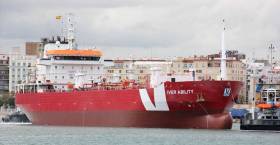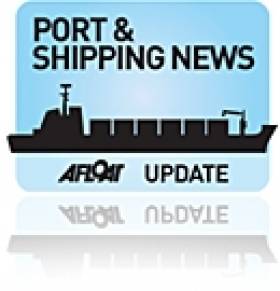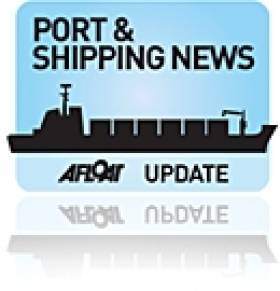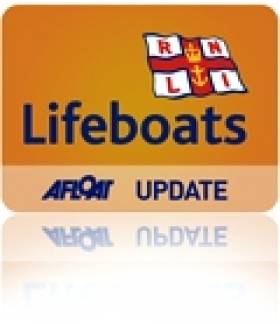Displaying items by tag: tanker
A Maltese flagged oil/chemical tanker which required emergency repairs is at the shipyard of Harland & Wolff, Belfast having arrived earlier this month, writes Jehan Ashmore.
The 127m red hulled tanker, Songa Crystal called to Belfast Lough on 8 January and is from a fleet of chemical, crude and product tankers. Afloat.ie has identified the tanker is part of Songa Shipholding, of the Blystad Group which owns the vessel and technically is managed by division, Songa Shipmanagement Ltd, based in Paisley, Scotland.
Once in the fairway in Belfast, Songa Crystal proceeded to H&W’s Belfast Dry-Dock, the smaller of two dry-docks at the marine engineering facility located on Queens Island.
Emergency repairs took place of the 12,927 deadweight tonnes (dwt) tanker which has Panama as a port and registry and was built in 2006 by Samho Shipbuilding, in Masan, South Korea.
During dry-docking of the 18 year-old tanker which has had two previous names, has seen the H&W team involved in extensive cleaning and replacing works to both the engine room. This has also applied to the fuel tanks and to the port and starboard side shells.
According to H&W, they have been liaising closely with the ship's staff, ships superintendent and classification society, which has led to efficiency that has enabled progress with the steel repair process.
This was to ensure that the Songa Crystal will be fully operational as soon as possible, as the tanker it is understood, is to depart this week to rejoin the 21 strong fleet, which ranges up to 25,000dwt.
#irishports - A most unusual caller to Dun Laoghaire Harbour took place recently with the arrival of a tanker marking a rare event that has not occurred in three decades, writes Jehan Ashmore.
Early on Sunday afternoon the 4,107 gross tonnage tanker Thun Gemini had arrived into the south Dublin Bay harbour.
According to Afloat sources the 2003 built ship is in port for maintenance reasons. Otherwise the 114m Dutch flagged tanker is a regular on the short sea route between Milford Haven, south Wales and the Irish capital.
It was soon after the arrival of Afloat to the port yesterday that came an unexpected surprise as the ship's stern free-fall lifeboat was launched. This led to the splash generated as the lifeboat made contact with the water close to the Carlisle Pier head.
The exersise to launch the enclosed orange lifeboat rekindled personal memories on the occasion of the previous tanker that visited the harbour. This took place in April 1989. More shall be revealed on Afloat next week on the 30th anniverary of that unique event which is among numerous chapter's that have enriched the harbour's maritime heritage.
Thun Gemini today remains berthed in port having sailed at the weekend the short distance from one of the four berths at the oil jetty terminal in neighbouring Dublin Port. The terminal has a 330,000 tonne facility handling oil products, bitumen, chemicals and liqued petroleum gases that are linked to a common user pipe line system.
The tanker is operated by Thun Tankers, part of Erik Thun AB as previously reported on Afloat.ie. The family owned shipping business is located in Lidköping on the southern shores of Lake Vänern, the third largest lake in Europe, which is connected to the sea by a shipping canal.
Christmas on Dublin Bay for 'Iver Ability' Tanker, Investigation into 'Cargo Reaction'
A red–hulled ship and her crew at anchor on Dublin Bay since August are set for a lonely Christmas on the capital's waters. The long term anchorage of the 'Iver Ability' follows a fire onboard the Asphalt/Bitumen Tanker during her transport of Bitumen into Dublin Port this summer.
This morning the ship is one of only two located in the Port's designated anchorage in the Southern Bay.
Initial enquires about what sources told Afloat.ie was 'an explosion' on board the ship drew a 'no comment' response from port authorities. This week the Dutch ship managers told Afloat.ie the 129m–vessel is the 'subject of an investigation' into how its cargo experienced a 'reaction' during operations in August.
Managers Iver Ships say following the reaction the 2006–built vessel was transferred to anchorage where she has become a talking point for many Dubliners around the shores of Dublin Bay.
The situation has, say the managers, 'stabilised with no further pressure release of the cargo occurring'. The exact cause of the cargo’s reaction is yet unknown. A full investigation is being conducted.
Iver Ability is currently still at anchorage in the port of Dublin and fully operational with all seafarers performing normal duties and standard crew changes taking place.
Discussions with charterers are ongoing on a port of discharge for the vessel’s cargo.
Caustic Soda Tanker Adrift 100 Miles Off Clare
#Tanker - RTÉ News reports that a tanker carrying 15,000 tonnes of caustic soda is adrift west of Loop Head after suffering engine failure.
The ship, carrying 22 crew, is said to be stranded amid rough conditions with Force 8 winds and a six-metre swell but is in no immediate danger. The Irish Coast Guard is on standby to provide assistance.
Transfer of Cargo from Stricken Tanker Delayed
#SHIPPING - The transfer of cargo from the damaged oil tanker sheltering at the entrance to Belfast Lough has been posponed for at least two more days.
As previously reported on Afloat.ie, the 228-metre Germar Companion - which is carrying 54,000 tonnes of vacuum gas oil - was redirected to Belfast after reporting a cracked hull en route from Rotterdam to New York.
The merchant vessel has been sheltering off the Copeland Islands since 16 December, where an official examination recommended removal of the cargo.
Today (31 December 2011) had been the scheduled start date for the move of the tanker's hazardous cargo by ship-to-ship tranfer. But the move has been delayed as the second ship, the BW Seine, is still en route to Belfast Lough.
"It is currently in the North Sea and could take another two days before it reaches the vessel and starts to transfer the cargo," a coastguard spokesperson told the Belfast Telegraph.
The transfer will be managed by specialist company Fendercare Marine in the lough, and could take between 24 and 36 hours. Once finished, the Germar Companion will sail into Belfast for repairs.
Cracks in Hull Force Tanker Re-Routing to Belfast
#SHIPPING - The Irish Times reports that a tanker carrying hazardous cargo has been allowed to berth at Belfast Port after it reported a cracked hull off the north-west coast.
The 228-metre Germar Companion, which is is carrying 54,000 tonnes of vacuum gas oil, was on route from Rotterdam to New York when its crew discovered cracking in its upper deck some 25 miles off Tory Island.
The Air Corps and Naval Service were stood down after the cargo ship was granted permission to berth at Belfast, where its hull will be inspected.
Wicklow Lifeboat Assists Fishing Vessel after Collision with Tanker
The alarm was raised after the collision took place about 20 miles off the Welsh Coast in the early hours of Monday morning. A volunteer crew from Holyhead RNLI lifeboat Station put to sea along with Wicklow lifeboat.The 3 crew of the beam trawler were uninjured in the incident, but the vessel sustained some damage to fishing gear, but no damage below the waterline. The tanker was able to resume her passage and no damage or pollution was reported.
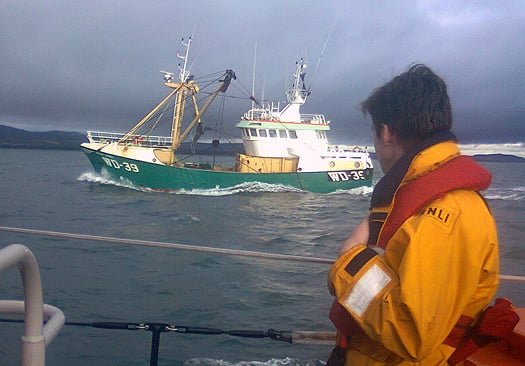
Wicklow RNLI lifeboat escorting the fishing vessel. Photo: RNLI/ Wicklow
The trawler was able to motor back towards the Irish Coast under escort by Holyhead lifeboat. At 07.33hrs Wicklow lifeboat arrived on scene. Holyhead lifeboat was then stood down and returned to station.
Wicklow lifeboat escorted the Beam trawler on the journey back to Wicklow harbour and was safely secured alongside the East pier by 10.30am.
The 3 crew were said to be shaken but uninjured after their ordeal.



























